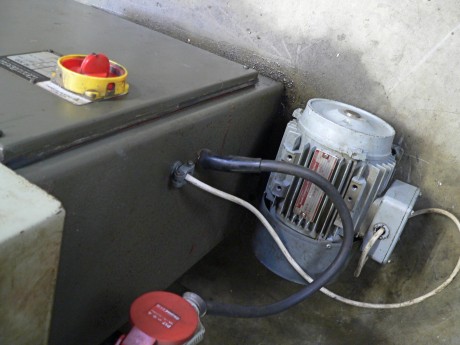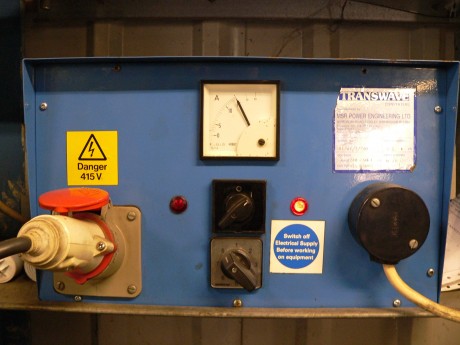Using a phase converter to run three phase machinery off a single phase supply
Saturday, March 13th, 2010Getting a three phase supply installed is extremely expensive, but there are workable alternatives for amateur engineers
For many years I had been using single-phase motors on my old workshop equipment. I managed with the inconvenience of not being able to quickly reverse motor direction and with the rather large size of motor for a given horsepower. Over the years I began to make more complicated parts for my hobby, old cars. I then bought a milling machine that had three motors, all of which were three phase. Getting a three phase supply connected would have been prohibitively expensive. Replacing the motors with single phase motors (two of which had to be easily reversible) would have been quite expensive, while the cost of a basic converter was only a little more than the cost of one motor. A converter could also be used with other equipment if needed.
Choosing a converter was not simple, manufacturers will always claim that there system is the best on the other hand some electricians haven’t a good word to say about them. Probably through good luck I purchased one that worked well for me and was relatively inexpensive. I think that someone who does not get on with a converter probably does not understand how to get the best out of it or has one that is not well matched to the application it is being used for.
You need a good input power supply because in stepping up from 240 volts to 415 volts there is some efficiency loss. A single phase 3 hp. motor will, momentarily, draw a load of 30 amps or more on start up, a three phase 3hp motor working off a converter will slightly exceed this on a 240 volt single phase supply. This means that 3 hp is the maximum that can be run off a normal domestic, 240 volt single phase supply. Larger motors can be started off load, but on load the available horsepower will drop back to a level dictated by the quality of the mains supply. The output of the transformer is still only single phase, the converter uses a bank of capacitors to produce the third phase and the result is not true three phase, just an approximation that allows the motor to run more smoothly than it would on a single phase supply. The capacitance required will depend on the design of the motor and on the horsepower required; in practice low rpm motors need a higher capacitance than a high rpm motor of the same horsepower. I have found that there is always a reduction in the output of any motor when it is run off a static converter, but I can live with this as the advantage of this as a much cheaper option outweighs the disadvantages.
Types of converter: There are two types of converter, static and rotary. Static converters use an adjustable amount of capacitance to generate the third phase and have an automatic ‘punch’ to help the motor start. Some static converters have sophisticated electronic components to improve their output, but this comes at some expense. A static converter can also be used in conjunction with a slave motor, which also improves the output. The output from any static converter is only an approximation to true three phase, but, for the hobbyist, it is a much cheaper option than a rotary converter. They are cheaper to purchase and to maintain, in twenty years I have only had to replace three capacitors in my converter. A true Rotary converter is basically a motor combined with a generator. They provide a true three phase output but are much more expensive to buy and to run, so are more suited to business use.
I use a basic, cheap, static converter. This caused some problems when I was using my lathe for a process, such as screw cutting, which involved changing speed and going from forward to reverse. A high speed required a higher converter setting because of the higher horsepower needed but in low speed on this setting the motor would run hot and noisily. The converter needed to be adjusted frequently, which wasn’t ideal. I discovered that running my large pillar drill at the same time as my lathe worked nearly as well as having a rotary converter, I could change from high to low speed and from forward to reverse without the motor running rough. It still had one disadvantage – I had to walk to and fro across my workshop to turn the pillar drill on and off.
 I decided to fit a slave motor. A friend gave me a motor, 1.5 KW at 2800 rpm, which I thought was too big for the converter to cope with as it had an output of 2.2 KW and I thought that the two motors starting simultaneously would put a total load of 3.7 KW on the converter on start up, but it was free so worth a try. I fitted a micro switch on the lathe so that the slave motor started a fraction of a second before the lathe, putting less strain on the converter. This worked better than I had hoped. Because the slave motor was not driving anything the converter coped very well, the slave was only drawing about 3amps on the single phase side, and the combined load of slave and lathe was about 15 amps. Because of noise and drag I modified the slave motor by cutting off the output shaft and reducing the diameter of the fan. The smaller fan is still able to keep the motor cool. In fact I did try removing it completely at one time but after about four hours of continuous use the motor was rather warm so I reinstated the cut-down fan. As you see in the photo I have wired my save motor at my lathe, in fact it can be wired in at any convenient point in the system.
I decided to fit a slave motor. A friend gave me a motor, 1.5 KW at 2800 rpm, which I thought was too big for the converter to cope with as it had an output of 2.2 KW and I thought that the two motors starting simultaneously would put a total load of 3.7 KW on the converter on start up, but it was free so worth a try. I fitted a micro switch on the lathe so that the slave motor started a fraction of a second before the lathe, putting less strain on the converter. This worked better than I had hoped. Because the slave motor was not driving anything the converter coped very well, the slave was only drawing about 3amps on the single phase side, and the combined load of slave and lathe was about 15 amps. Because of noise and drag I modified the slave motor by cutting off the output shaft and reducing the diameter of the fan. The smaller fan is still able to keep the motor cool. In fact I did try removing it completely at one time but after about four hours of continuous use the motor was rather warm so I reinstated the cut-down fan. As you see in the photo I have wired my save motor at my lathe, in fact it can be wired in at any convenient point in the system.
I can now run the slave whenever it is needed or isolate it when it is not needed and, because of the better phase characteristics, the motors will start more easily under load. I use the converter without the slave when the job in hand means that a constant load is applied and quick changes of direction are not necessary.
The slave motor allows me to start various motors with a wide range of load settings and of differing horsepowers without altering the capacitor setting on the converter. It also allows me to reverse the motor direction without having to wait for the motor to stop. Some motors will be very chattery when running on light loads and a fractional horsepower motor might not even start without the slave running (using a static converter larger than 2.5KW will cause difficulty in starting a fraction horsepower motor without also using a slave motor).
To sum up, for my converter I need a slave motor that has at least ¾ of the maximum output of the converter, the slave must run at 2800 rpm. (A slower, 1425 rpm motor will help a bit but can run very hot and rough when load is removed from the converter. In addition, with very little kinetic energy stored, start-up will be poor on higher hp motors.) I have modified all of my machine tools that have multiple motors so that all the motors start and stop simultaneously. This greatly reduces the risk of accidental damage to fractional hp motors that could occur when the main motor is stopped leaving the fractional ones running because the capacitance setting would then be too high and the motors would overheat very quickly. Another point to bear in mind is that you can never take for granted that motors of the same hp and rpm but different makes will perform equally well, the design of each motor can make a difference. I have a total of 11 motors on five machines and in 20 years of running these on my converter I have never had one give trouble by overheating.
